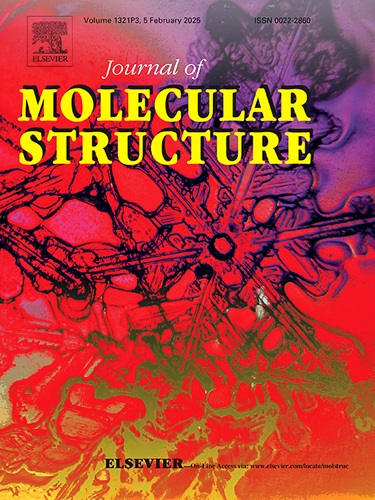Synthesis, computational analysis, and exploring antiproliferative activity of triazolo- and thiazolo-pyrimidine derivatives as potential EGFR inhibitors
IF 4
2区 化学
Q2 CHEMISTRY, PHYSICAL
引用次数: 0
Abstract
Anticancer drug acquiring usually discloses with an in vitro testing in cell panels to certainly detect the lead compounds. EGFR is a tyrosine kinase cell surface receptor that plays a key function in signal transduction processes and is observed on most cell surfaces. One of the promising frameworks in drug detection is pyrimidine and its fused heteroannulated bicyclic derivatives which exhibited promising anticancer activity. The prepared triazolopyrimidine and thiazolopyrimidine derivatives were proposed to fit into the ATP binding site of EGFR protein. The in vitro antiproliferative screening against MCF7 and HCT116 cancer cell panels disclosed the most influence of triazolopyrimidine 3, thiazolopyrimidine 9, and pyrimidinethione 1 compared to the reference drug, roscovitine (imidazopyrimidine hybrid). The inhibitory action of the most promising compounds was explored versus EGFR enzyme, which displayed the highest efficacy of triazolopyrimidine 3 compared to the standard drug (erlotinib). The structure-activity relationship (SAR) probe demonstrated that specific structural modifications had a significant impact on the antiproliferative action. In silico molecular docking was performed on these promising compounds versus EGFR enzyme (breast cancer protease, PDB ID: 3W32) to show the enzyme-inhibitor interactions, which uncovered the superlative binding interactions of triazolopyrimidine 3 with key nucleobases and amino acids of EGFR kinase. Among DFT calculations, ELUMO of compounds 3 < 1 < 9, which enriched its binding affinity of with nucleophilic receptor's active pockets. Regarding ADME simulation, they had gastrointestinal tract (GIT) absorption, good bioavailability score, and worthy lead-likeness. This work may contribute to developing new effective EGFR inhibitor.

求助全文
约1分钟内获得全文
求助全文
来源期刊

Journal of Molecular Structure
化学-物理化学
CiteScore
7.10
自引率
15.80%
发文量
2384
审稿时长
45 days
期刊介绍:
The Journal of Molecular Structure is dedicated to the publication of full-length articles and review papers, providing important new structural information on all types of chemical species including:
• Stable and unstable molecules in all types of environments (vapour, molecular beam, liquid, solution, liquid crystal, solid state, matrix-isolated, surface-absorbed etc.)
• Chemical intermediates
• Molecules in excited states
• Biological molecules
• Polymers.
The methods used may include any combination of spectroscopic and non-spectroscopic techniques, for example:
• Infrared spectroscopy (mid, far, near)
• Raman spectroscopy and non-linear Raman methods (CARS, etc.)
• Electronic absorption spectroscopy
• Optical rotatory dispersion and circular dichroism
• Fluorescence and phosphorescence techniques
• Electron spectroscopies (PES, XPS), EXAFS, etc.
• Microwave spectroscopy
• Electron diffraction
• NMR and ESR spectroscopies
• Mössbauer spectroscopy
• X-ray crystallography
• Charge Density Analyses
• Computational Studies (supplementing experimental methods)
We encourage publications combining theoretical and experimental approaches. The structural insights gained by the studies should be correlated with the properties, activity and/ or reactivity of the molecule under investigation and the relevance of this molecule and its implications should be discussed.
 求助内容:
求助内容: 应助结果提醒方式:
应助结果提醒方式:


